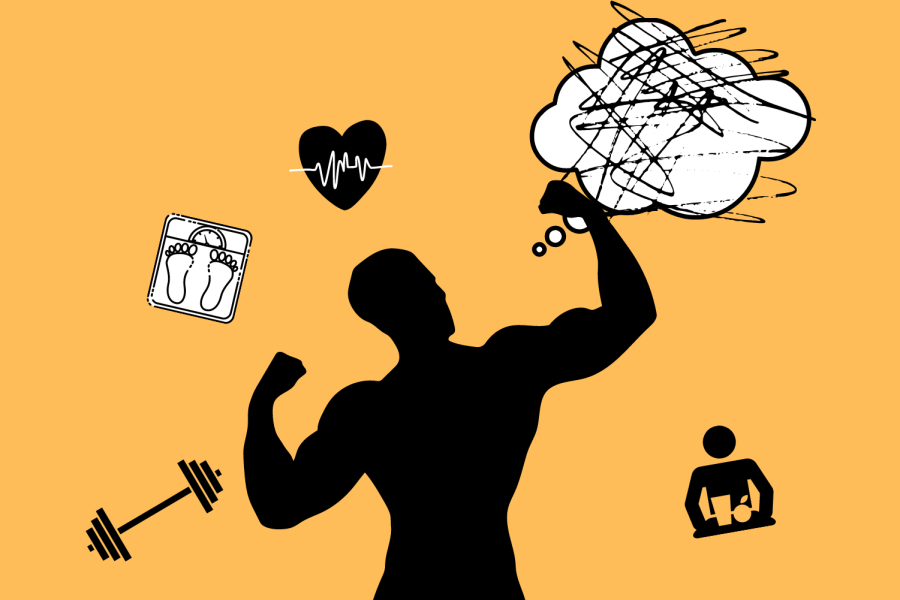OPINION: Diet and Exercise Culture Harms Teenagers
The culture surrounding diets and exercises, especially in various P.E. classes, can be harmful to the mental and physical health of teenagers.
A graphic of someone suffering with body image issues due to diet and exercise culture.
Apr 17, 2022
The culture surrounding diets and exercises, especially in various P.E. classes, can be harmful to the mental and physical health of teenagers. The expectations of young girls and boys to stay young has no better example than in the weights room. These insecurities are easy to take advantage of, and the diet and exercise industry does not hesitate to.
According to hopkinsmedicine.org, teenagers between the ages of 12 and 25 are most likely to develop an eating disorder. This means that high school is the prime time to develop insecurities about one’s growing body, and the time that they are most likely to develop an eating disorder. With eating disorders like anorexia nervosa and bulimia nervosa, excessive exercise is closely linked to the disorders, in both developing and maintaining them. According to behavioralnutrition.org, nearly a third of children age 5 to 6 choose an ideal body size that is thinner than their current perceived size.
This kind of mindset is normalized in this society for young boys and girls. The desire to be thin and the desire to be muscular harms children when they’re at their most vulnerable, and it doesn’t necessarily fade with time.
In high schools across America, students can participate in weightlifting classes that can introduce healthy exercise habits and lead to physical fitness. Underneath the cover of healthy exercise is the less-often discussed prevalence of body image and eating disorders in men.
“Men who were dissatisfied with their body fat were more likely to report symptoms of eating disorders, such as avoiding certain foods, being terrified about being overweight, and being preoccupied with a desire to be thinner,” an article from news.osu.edu said.
The weight room is a fertile breeding ground for toxic mindsets based around being lean, muscular, and strong. Just as women are shown the perfect body to aspire to be – thin, hairless, soft skinned, and naturally blemish free – men are shown the same. They are told to be tall, muscular, and lean. This is a goal that is almost impossible to attain for most regular people; i.e., those that are not rich with access to personal trainers and any food they can wish for, and even more difficult for a teenage boy with unbalanced hormones and emotions to attain. A lack of transparency in the weightlifting and bodybuilding community on the use of steroids makes the situation even more dire. The use of testosterone and chemical boosters is incredibly common in those participating at the expert level, but is not always made explicit. This means that young boys and men that aspire to be like their weightlifting idols are fed nothing but lies, yet they are told it’s possible through hard work alone. This is an impossible task for teenagers, and yet they toil for hours to do so.

This insurmountable task is not only shown to teenagers through the media, but at school as well. At GEHS, the Lifetime Fitness class sports a yearly Weight Loss unit. Despite many students voicing their dislike for how the unit is worded, it persists year after year. Health class, which is required for all students to graduate, has used weight loss apps and calorie trackers in the past. According to a study conducted by Duke University, out of 105 study participants with disordered eating who used a calorie tracking app, “73.1% identified the app as a contributor to their eating disorder symptoms.” This vicious cycle is so easily started and maintained, yet so difficult to stop.
Student athletes are some of the most susceptible to these notions. The need to be always stronger and faster, but still small enough to fit into the tight cheer uniform or make the wrestling weight cut is not unnoticed. It is not uncommon for someone who is still growing into their body and dealing with hormonal changes to be discouraged from a school sport on the basis of their body, or not looking like the other team members. According to nationaleatingdisorders.org, “When the pressures of athletic competition are added to an existing cultural emphasis on thinness, the risks increase for athletes to develop disordered eating”, and “In a study of Division 1 NCAA athletes, over one-third of female athletes reported attitudes and symptoms placing them at risk for anorexia nervosa.”
Revealing uniforms increases also stress for NCAA athletes. According to ncaa.org, “One study found that 45 percent of swimmers surveyed reported a revealing swimsuit as a stressor. Another study in volleyball found not only that revealing uniforms contributed to decreased body esteem but also distracted players and negatively affected sport performance.”
Additionally, part of the weightlifting classes at GEHS is a quarterly weigh in. While the students aren’t told their weight, even just the act and ceremony of lining up to weighed and measured is nerve wracking for students. The day of, or even the day before, it’s not unheard of to listen in on students not eating proper lunch or breakfast to maintain a lower weight, and therefore, a better metaphorical “score”. The value placed on the thinness of young girls and the impossible muscularity of young men in our society is not something to ignore.






